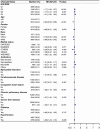Combined glycated hemoglobin index and red cell distribution width predict in-hospital mortality in critically ill sepsis patients based on MIMIC-IV analysis
- PMID: 40210921
- PMCID: PMC11986117
- DOI: 10.1038/s41598-025-94179-8
Combined glycated hemoglobin index and red cell distribution width predict in-hospital mortality in critically ill sepsis patients based on MIMIC-IV analysis
Abstract
Red cell distribution width (RDW) and glycated hemoglobin index (HGI) is considered an important tool for assessing the prognosis of sepsis patients, closely related to the risk of mortality associated with sepsis. This study investigates the association between the HGI combined with RDW and the risk of in-hospital mortality in patients with sepsis. We analyzed data from 13,726 sepsis patients who were admitted to the intensive care unit (ICU) for more than 24 h, sourced from the American Medical Information Mart for Intensive Care (MIMIC-IV) database. Kaplan-Meier survival curves and multivariable Cox regression analyses were employed to assess the impact of various variables on patient outcomes, stratified by quartiles of HGI and RDW. Additionally, restricted cubic spline (RCS) analysis was utilized to explore how changes in HGI and RDW might influence the studied outcomes. The results indicated that the highest quartile (Q4) of the combined metrics significantly increased in-hospital mortality compared to the lowest quartile (Q1) (p < 0.0001). Multivariable Cox regression analysis revealed that patients in Q4 faced the highest risk of in-hospital mortality (hazard ratio: 1.22, 95% confidence interval: [1.10-1.36], p < 0.001). RCS analysis demonstrated a nonlinear relationship between HGI-RDW and the risk of adverse outcomes. Further analysis identified significantly elevated risks in patients over 65 years old, those who were widowed, those receiving macrolide antibiotics, and those with congestive heart failure or severe liver disease. In conclusion, elevated levels of the combined HGI and RDW metrics are independent risk factors for adverse outcomes in critically ill patients with sepsis, associated with increased mortality.
Keywords: Glycated hemoglobin index; MIMIC-IV; Red cell distribution width; Sepsis.
© 2025. The Author(s).
Conflict of interest statement
Declarations. Competing interests: The authors declare no competing interests. Ethics statement: The MIMIC-IV database has obtained approval from the Institutional Review Boards of Beth Israel Deaconess Medical Center and the Massachusetts Institute of Technology.
Figures







Similar articles
-
Hemoglobin glycation index and neutrophil percentage as predictors of congestive heart failure among individuals diagnosed with sepsis: A MIMIC-IV cohort study.Sci Rep. 2025 Jul 25;15(1):27099. doi: 10.1038/s41598-025-12453-1. Sci Rep. 2025. PMID: 40715448 Free PMC article.
-
Association between hemoglobin glycation index and mortality in critically ill patients: a retrospective cohort study.J Health Popul Nutr. 2025 Jul 12;44(1):249. doi: 10.1186/s41043-025-01008-9. J Health Popul Nutr. 2025. PMID: 40652238 Free PMC article.
-
The relationship between hemoglobin glycation index and all-cause mortality in ill critically patients with heart failure: a retrospective study in MIMIC-IV database.BMC Cardiovasc Disord. 2025 Apr 24;25(1):317. doi: 10.1186/s12872-025-04711-x. BMC Cardiovasc Disord. 2025. PMID: 40275131 Free PMC article.
-
Risk and mediation analyses of hemoglobin glycation index and survival prognosis in patients with sepsis.Clin Exp Med. 2024 Aug 7;24(1):183. doi: 10.1007/s10238-024-01450-9. Clin Exp Med. 2024. PMID: 39110305 Free PMC article.
-
A retrospective study utilized MIMIC-IV database to explore the potential association between triglyceride-glucose index and mortality in critically ill patients with sepsis.Sci Rep. 2024 Oct 15;14(1):24081. doi: 10.1038/s41598-024-75050-8. Sci Rep. 2024. PMID: 39402158 Free PMC article.
References
-
- Jacobi, J. The pathophysiology of sepsis – 2021 update: part 2, organ dysfunction and assessment[J]. Am. J. Health Syst. Pharm.79 (6), 424–436 (2022). - PubMed
MeSH terms
Substances
Grants and funding
LinkOut - more resources
Full Text Sources
Medical

